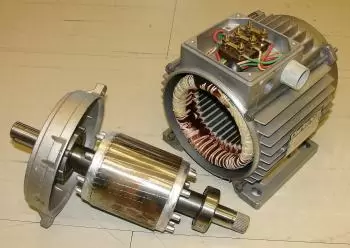
Electric motors can be distinguished among themselves according to the type of supply current:
- DC electric motors. The direct current electric motor can be, in turn, a permanent induction motor or a direct induction motor. In addition to these more general classifications, there are also other more modern types of motors, such as stepper motors and linear motors.
- Alternating current electric motors. AC motor can be classified as universal motor, synchronous motor or asynchronous motor.
The classic division is between direct current (DC) and alternating current (AC) motors. However, it is not an extremely precise classification, since there are motors that are constructively similar to direct current motors that can also be supplied in alternating current, called universal motors. Different distinctions can be made based on other references: for example, the distinction between synchronous motors, in which the power frequency is equal to a multiple of the rotational frequency, and asynchronous, in which the two frequencies are different. ; Therefore, generally the categories in which the electric motor is classified are asynchronous motor, synchronous motor or direct current motor.
- Synchronous motor. The synchronous motor is a type of alternating current electric motor in which the stator, generally three-phase, generates a rotating magnetic field. In the rotor there is a magnetic field (generated by a permanent magnet or a continuous fed winding) that is attracted by the rotating magnetic field of the stator, which generates the motor torque.
- asynchronous motor. The asynchronous motor is a type of alternating current electric motor in which the rotation frequency is not the same or a submultiple of the mains frequency, that is, it is not "synchronous" with it; That is why it stands out from synchronous motors. Asynchronous motor is also called induction motor due to its working principle.
Direct current (DC) motor with permanent induction
The DC motor is the simplest motor. We start from the outside, where the casing or casing is, which has a fixing system to the bedplate or chassis, in which there is a set called a stator or inductor, formed by a sheet metal support, and some magnets or electromagnets.
Further inside is the rotor, which is formed by a core of plates on a shaft that supports everything surrounded by a series of windings that are connected to the collector bars, which is where they receive the electric current; all of this is supported by the bearings at the ends of the crankcase.
On one side of the shaft is the pulley, ring gear or coupling, which transmit the mechanical energy to be used. When the current is passed through the brushes to the collector, an electric current is passed through the conductors of the coils, which creates a lateral force, and the sum of all of them gives us the torque that makes the rotor assembly rotate or motor. Through the collector, current is given to the appropriate coils so that this torque is as strong as possible. They are the motors that are in devices that are moved by batteries or batteries.
DC motor with variable induction
The DC motor with variable induction is the same as the permanent induction motor, but in this case what produces the field are coils that work like an electromagnet, and are connected to the rotor in series or parallel. This motor also works with single-phase alternating current.
The most common example is the motors of household appliances in normal use.
Asynchronous AC Motor
In the stator there are three groups of windings, which correspond to the three phases of commercial alternating current, and the rotor instead of the collector, has three rings, which are connected to the rotor windings, it works by the same principle, although due to When moving between phases, a rotating field is produced, which in a certain way drags the rotor.
A particular case or widely used construction is the squirrel cage, since it is a very simple motor, in which the blades and rotor windings are replaced by rods with rings at the ends joining the rods, hence its name. .
In asynchronous motors, the windings can be connected in two ways: Star, when one end of the windings is common and the other is connected to each of the phases. The other is in triangle, when the ends of the coils are connected to each other and to a phase. The exchange of two phases causes the reversal of the direction of rotation.
It is the most commonly used motor in the industry, with the star delta starting system.
Synchronous AC Motor
Synchronous motors are so called because the speed of rotation is related to the frequency of the supply current, this is due to the fact that the rotor is fed with direct current, and is dragged by the rotating field produced by the coils of the rotor. stator.
They normally have a dynamo coupled to the same motor shaft to power the rotor. As the speed varies with the frequency and that allows setting the motor torque with a minimum consumption, by being coupled to an oscillator its speed can be varied very easily, and therefore it is used in traction systems (AVE - TGV).
Stepper motors
It is powered by direct current, and the rotor contains a series of permanent magnets, which are driven by the stator coils, which are governed by power electronics, determining the angle of rotation, those with proportional control, are extremely precise in the angle of twist, or position. These motors are widely used in numerical control machine motion servos, or in read/write motors for computer hard drives.
Linear motor
Basically, it is an asynchronous motor that has been developed, so instead of creating a rotating torque, it creates a linear displacement, due to the displacement of the phases.